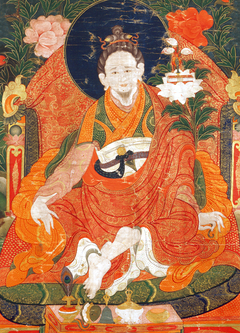Vajra Verses on the Natural State
English | Français | 中文 | བོད་ཡིག
Vajra Verses on the Natural State
revealed by Rigdzin Jigme Lingpa
Homage to the glorious Samantabhadra!
The natural state of the ground is free from complexity,
And ground-appearances are rigpa-dharmakāya.
The path has always been clear of effort, from the very beginning.
When this nature itself is realized, it is the great source of freedom.
The fruition is not something separate and set apart.
When the result itself is present as cause,
Settling completely is calm abiding (śamatha).
Any sudden rising is rigpa's own radiance,
And vivid awareness is insight (vipaśyanā).
Directly, upon fading, there's primordial experience.
Remaining genuinely is the dharmakāya,
Accompanying awareness is the sambhogakāya,
And the non-duality of stillness and movement is the nirmāṇakāya.
This is what we call the “three-kāya rigpa.”
While remaining at ease, there's no clinging to experience.
Vivid movements of mind are freed, ungraspable.
Liberated in vivid clarity, there's no post-meditative state of mind.
This is what we call the “spontaneously present three kāyas.”
Without any deliberate view, it is beyond dullness and agitation.
Without deliberate meditation, it is entering the original 'womb'.
Without deliberate conduct, it is free from rigid notions or ideas.
One who has mastered this is a “lord among yogis.”
If you are aware of a thought as it suddenly appears,
And can sustain the continuity of recognition,
That is insight (vipaśyanā) gone astray in character.
It can also be referred to as “post-meditation.”
But it's not the freeing of thoughts as dharmakāya,
And we must cut directly to the source.
Rigpa has always been free from conceptual elaboration.
Conventions such as 'view', 'meditation' or 'conduct' and
Any clinging to them is cleared, without basis or origin.
Good thoughts, bad thoughts, and those in between,
Without slipping into any such categorization,
Are freed upon arising, without any agent to make distinctions.
As long as awareness does not lose its own ground,
There is no need for anything more than this.
Even if you were to meet a hundred scholarly monks, a thousand siddhas,
Ten thousand translators and pandits, a hundred thousand instructions,
Or a billion treatises, still there'd be no call to clarify uncertainty or doubt.
Samaya. Let the signs be absorbed.
To my only son, Khyentse Özer, this was given by the Samantabhadra of awareness in the manner of a transmission of blessings and realization. Do not show it to anyone, but conceal it in your heart.
Thus, in the Akaniṣṭha cave on the twenty-sixth day of the Month of Miracles, at a time when the ḍākinīs gathered during my dark retreat, I set this down on a side of precious paper.
This profound aural transmission is sealed with atham.
Only this! Only this!
The contents are elaborated upon in The Words of the Omniscient One.
| Translated by Adam Pearcey, 2015, at the request of Dza Kilung Rinpoche. The translator is indebted to Sam van Schaik, whose excellent version of this text appears in Approaching the Great Perfection (Boston: Wisdom Publications, 2004, pp. 170–171). Any significant differences in interpretation here are based on our reading of Yukhok Chatralwa Chöying Rangdrol's commentary. Revised in 2019, with the kind assistance of Khenpo Yeshi.
Version: 2.1-20230926
